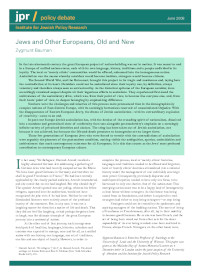Jews and other Europeans - Old and new
Author(s)
Publication Date
Publisher
Abstract
In the late nineteenth century the great European project of nation-building was set in motion. It was meant to end in a Europe of unified nation-states, each with its own language, history, traditions and a people undivided in its loyalty. The local or ‘merely ethnic’ communities would be effaced, subsumed into the homogeneous nation. Assimilation was the means whereby outsiders would become insiders, strangers would become citizens.
The Second World War, and the Holocaust, brought this project to its end, laying bare the contradiction at its heart. Outsiders could not be assimilated since their loyalty was, by definition, always voluntary and therefore always seen as untrustworthy. As the historical epitome of the European outsider, Jews accordingly remained suspect despite all their ingenious efforts to assimilate. They experienced first-hand the ambivalence of the assimilatory drive, which was, from their point of view, to become like everyone else, and, from their hosts’ point of view, to deepen belonging by emphasizing difference.
Nowhere were the challenges and miseries of this process more pronounced than in the demographically complex nations of East-Central Europ. With the disappearance of Eastern European Jewry, the drama of Jewish assimilation came to an end.
In post-war Europe Jewish assimilation has, with the demise of the crusading spirit of nationalism, dissolved into a mundane and generalized show of conformity that runs alongside postmodernity’s emphasis on a seemingly infinite variety of privatized identities and choices. The sting has been taken out of Jewish assimilation, not because it was achieved, but because the life-and-death pressures to homogenize are no longer there.
Those few generations of European Jews who were forced to wrestle with the contradictions of assimilation were arguably the pioneers of the postmodern condition, making visible the ambiguities that mark contemporary existence for all Europeans. It is this that counts as the Jews’ most profound contribution to contemporary European culture.
The Second World War, and the Holocaust, brought this project to its end, laying bare the contradiction at its heart. Outsiders could not be assimilated since their loyalty was, by definition, always voluntary and therefore always seen as untrustworthy. As the historical epitome of the European outsider, Jews accordingly remained suspect despite all their ingenious efforts to assimilate. They experienced first-hand the ambivalence of the assimilatory drive, which was, from their point of view, to become like everyone else, and, from their hosts’ point of view, to deepen belonging by emphasizing difference.
Nowhere were the challenges and miseries of this process more pronounced than in the demographically complex nations of East-Central Europ. With the disappearance of Eastern European Jewry, the drama of Jewish assimilation came to an end.
In post-war Europe Jewish assimilation has, with the demise of the crusading spirit of nationalism, dissolved into a mundane and generalized show of conformity that runs alongside postmodernity’s emphasis on a seemingly infinite variety of privatized identities and choices. The sting has been taken out of Jewish assimilation, not because it was achieved, but because the life-and-death pressures to homogenize are no longer there.
Those few generations of European Jews who were forced to wrestle with the contradictions of assimilation were arguably the pioneers of the postmodern condition, making visible the ambiguities that mark contemporary existence for all Europeans. It is this that counts as the Jews’ most profound contribution to contemporary European culture.




